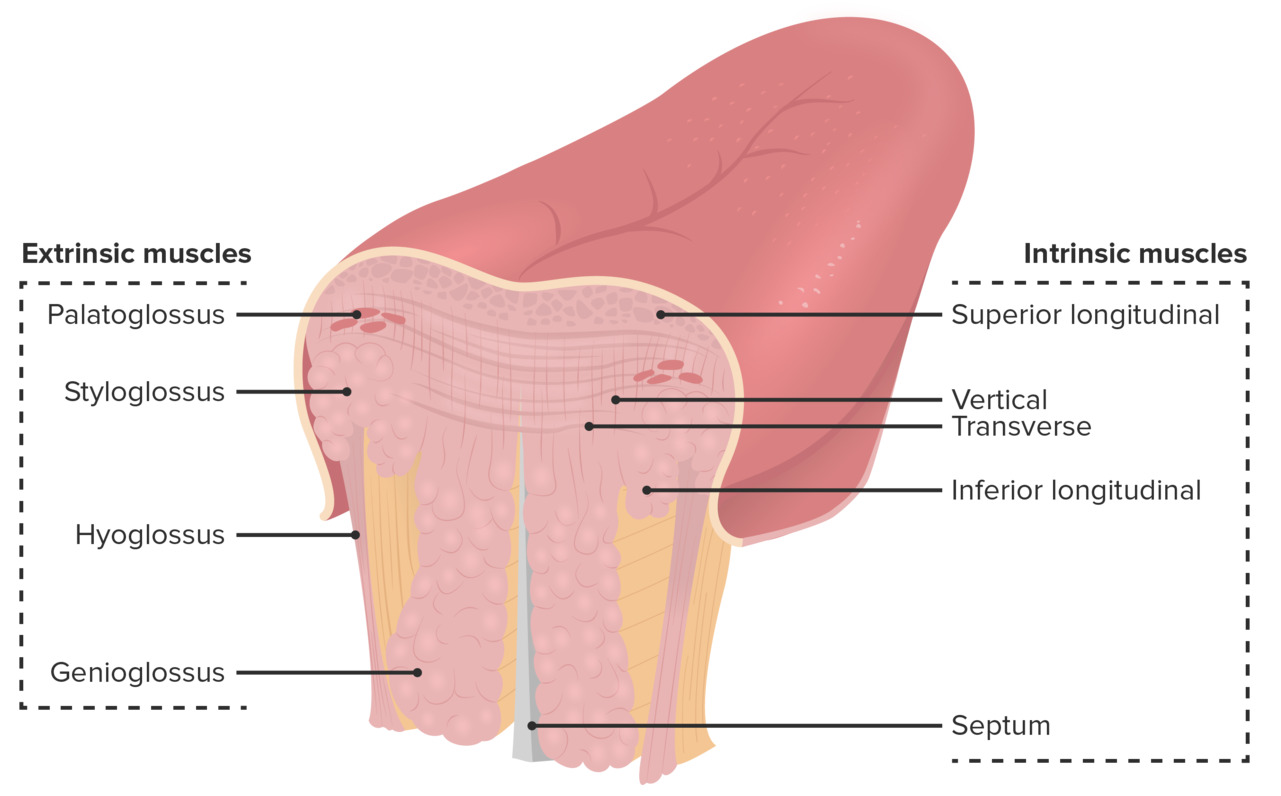Playlist
Show Playlist
Hide Playlist
Tongue
-
Slides Digestive system oral cavity.pdf
-
Reference List Histology.pdf
-
Download Lecture Overview
00:01 Let's move now to looking at the tongue. 00:04 On the left hand side you can see on the bottom a section through the tongue. 00:12 You can see, if you look very carefully, red stained material in the inner part of the section, there are sections through all the striated muscle of the tongue. 00:27 And on the periphery, you can see a very bluey greeny stained component, that's the connective tissue that supports the epithelial surface of the tongue and the more flattened top surface is the dorsal part of the tongue and the bottom part is the ventral part of the tongue. 00:48 And on the diagram above that you can see an explanation of the various types of the papillae on the dorsal surface of the tongue. 00:58 You have filiform papillae which you see illustrated on the bottom left hand side in the histological section, these are just like bulbs of keratin, processes spikes of keratin sticking out from the surface. 01:15 You can also see them on the top histological section particularly on the right-hand side. 01:21 On the top histological section, you can see a mushroom shaped papilla or projection of the dermis of the underlying connective tissue into the papillae. 01:37 It's not dermis, its connective tissue. 01:39 Dermis only refers to the projection of underlying connective tissue into the epithelium of the skin. 01:46 These fungal formed papillae can also have taste buds. 01:51 They look like a mushroom humps they call fungiform. 01:55 And then you have these large circumvallate papillae that you can see in the diagram on the top left-hand side. 02:03 Now these papillae they have two major roles. 02:09 The fungi form and also more obviously the circumvallate papillae has taste buds. 02:16 The other papillae, the buds of keratin in the filiform papillae, help us to be able to use the tongue as a shovel, if we didn't have those particular papillaes the tongue would slip off the masticating mucosa. 02:36 It wouldn't be able to shovel food around because the food would just simply slip off. 02:41 You wouldn't be able to lick an ice cream so they are important for that reason. 02:49 Let's have a look at a circumvallate papillae in more detail. 02:54 You can see it on the top labeled diagram on the left-hand side it's a large circulars structure on the right-hand side you can see It on the top labeled there, it's a large projection of underlying connective tissue creating this papilla and you can see troughs on either side, those troughs again would be very important because they receive secretion product I'll mention in a moment. 03:24 If you look very carefully at the surface of these circumvallate papillae that's where you'll find many, many taste buds so that's a good place to study the structure of the taste bud, and the taste bud is showing down here on the right-hand side histological section. 03:42 They are very specialized structures often it's easy to mistake them for projections of the underlying connective tissue into the epithelial surface like you see when an epithelial adheres very closely to an underlying connective tissue, but these are not connective tissue components. 04:04 They are specialized neuroepithelial cells and supporting cells, taste receptors. 04:11 And often you could get a good orientation you can see a little taste pore at the surface of these taste buds and that's illustrated on the left-hand bottom diagram, the drawing. 04:25 These taste buds are very similar to the olfactory receptors we see in olfactory epithelium in the nasal cavity for detecting smell essentially these taste buds contain the receptor cells that have microvilli projects the donum that have receptors for detecting various dissolved substances in the saliva that bathe past these taste buds and the special neuroepithelial cells then carry that sensation back to the central nervous system. 05:04 They carry it back through the central nervous system by the cord of tympani nerve which is part of the facial nerve or the seventh cranial nerve and also sometimes the sensation of taste can go back via the Glossopharyngeal or Vagus nerve, the cranial nerves IX and X respectively. 05:31 Now, what is important though is that I mentioned the glands, the troughs around the circumvallate papillae at the top. 05:41 There are special glands in the internal surface just underneath the surface of these papillae and those glands are called Von Ebner's gland secrete a watery fluid continually through that trough and continually pass the taste buds and that flushes out continually the dissolved substances so we can taste things regularly. 06:08 The taste doesn't linger on our taste buds or in that location because the flushing out of these particular secretions.
About the Lecture
The lecture Tongue by Geoffrey Meyer, PhD is from the course Gastrointestinal Histology.
Included Quiz Questions
Which of the following is NOT a type of papillae of the tongue?
- Lacunae
- Circumvallate
- Fungiform
- Filiform
- Foliate
Which of the following types of tongue papillae is also known as 'mushroom like'?
- Fungiform
- Filiform
- Circumvallate
- Laminal
- Foliate
Fungiform papillae CANNOT distinguish which of the following tastes?
- Fungiform papillae can distinguish all the tastes provided in the options.
- Sour
- Bitter
- Salty
- Sweet
Which of the following cranial nerves receives taste sensations from the anterior two-thirds of the tongue?
- VII
- I
- VI
- IV
- VIII
What is the major function of Von Ebner’s glands?
- Flushing out material to enable the taste buds to respond rapidly to changing stimuli
- Antimicrobial action
- Buffering and better protection from dental caries
- Soft tissue repair by decreasing clotting time and increasing wound contraction
- Food digestion
Which ONE of the following statements is INCORRECT?
- The tongue has abundant bundles of smooth muscle supported by collagenous connective tissue.
- Filiform papillae enable the tongue to manipulate food up against the hard palate.
- Circumvallate papillae have taste buds.
- Fungiform papillae have taste buds.
- Papillae are located on the dorsal surface of the tongue.
Customer reviews
3,0 of 5 stars
| 5 Stars |
|
0 |
| 4 Stars |
|
1 |
| 3 Stars |
|
1 |
| 2 Stars |
|
1 |
| 1 Star |
|
0 |
there is no subtitle and marks on the slide are not good enough to understand lecture
questions don't go along well with the lecture sometimes questions pops out before discussed. AND please mark. i kept getting lost and try to figure which part you're talking about.
Difficult to follow many of Dr. Meyer's course because of poor marking of the area under discussion. Also, questions jump into the middle of lecture, very disruptive.




